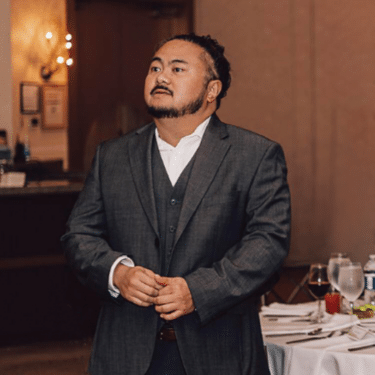In the wake of mysterious symptoms, Renato Tosoc searches for answers and a treatment protocol that works for him
For 42-year-old Renato Tosoc, the mystery began in fall of 2019, when he moved from Chicago to the Philippines for a one-year work assignment to help set up a new call center for JP Morgan. His parents had migrated from the Philippines in the 1960s, and he was grateful for the opportunity to spend time there.
Then, a few months after arriving, he began experiencing all-over pain and other unexplainable symptoms.

“I woke up to go to the bathroom, and my abs, shoulders, and toes were super sore,” he says. Upon standing, he felt dizzy, and then, “I noticed little red spots on my face.”
When the symptoms persisted, Tosoc went to the emergency department. He met with an infectious disease doctor, but the specialist didn’t have an explanation for his symptoms. Confused and worried, Tosoc decided to fly home for Christmas.
During the flight, he experienced a seizure — stiff, jolting convulsions. The episode lasted a couple of minutes.
“People were helping me when I came to and asking if I was ok. I had no idea what was going on,” Tosoc says.
A doctor on the flight told him what had happened. “I still had another 10 hours of flight over the Pacific, and I was trying to process it all,” he says. He was also worried he might have another seizure in flight.
When he landed at O’Hare, Tosoc’s brother drove him to an emergency department. There, a neurologist diagnosed him with epilepsy, a condition in which nerve cell activity in the brain is disturbed, causing seizures.
Understanding epilepsy
While some forms of epilepsy more commonly begin in childhood, Adriana Bermeo-Ovalle, MD, a neurologist at Rush University Medical Group, says it can occur any time during a person’s life. “Any lesion of the brain that involves the cortex of the brain can cause epilepsy at any age,” she says.
A number of different issues — including structural, genetic, metabolic, and autoimmune, as well as infections — can cause epilepsy, according to The Epilepsy Foundation. However, the cause is unknown in about half of people with the condition. Tosoc falls into this group.
For a person like Tosoc, who began having seizures as an adult, Amit Ray, MD, a neurologist specializing in the treatment of epilepsy at NorthShore Medical Group, says doctors will try to evaluate for structural abnormalities that could have led to the seizure. Examples of these abnormalities include physical trauma, stroke, and tumor. If they do find something, they may need to treat both the cause and seizure. If there’s a tumor, for example, the person may need to have surgery to remove it.
“We have to have a thorough investigation to try to identify the cause,” Ray says.
There are several types of seizures, with generalized tonic-clonic seizures (also known as grand mal) the most recognized. In this type of seizure, the body becomes stiff, and the person’s arms and legs move in uncontrolled, jerking motions. Other kinds of seizures involve staring spells, atypical head movements, stiffness in extremities, and time loss.
No matter the seizure, they all carry risks. If the person is driving when the seizure happens, they could crash their car; if walking, they could fall.
Since his diagnosis, Tosoc takes public transportation to work and throughout the city. His doctors also recommend that he avoid having pointy furniture and keep from climbing ladders, taking baths, and swimming alone. He keeps a seizure alarm app on his phone that alerts his brother if a seizure occurs.
“Epilepsy is more than experiencing seizures. It’s the physical pain of the seizure itself and the mental struggle of before and after — thinking about when I’m going to have the next one and how I’m going to stop it,” Tosoc says.
The mental and emotional strain of epilepsy is a concern, notes Bermeo-Ovalle. She says up to 30% of patients with epilepsy have depression, anxiety, or both. “We have grown more aware that there are a lot of other symptoms that come with epilepsy, such as mental-health-related symptoms, that our patients need help with in a proactive way,” she says.
The reason for mental health conditions may not be just from the fear of having an unknown seizure, Ray says. “It may be something inherent in the disease process itself that causes depression or anxiety.”
Hope in treatment options
For Tosoc, solving one mystery — his epilepsy diagnosis — has led to a new one. He now is on the hunt for a medication and lifestyle combination that will keep him seizure-free.
While there is no cure for epilepsy, about 60% to 70% of people may gain control of their seizures after a number of years, the Epilepsy Foundation reports.
“For the vast majority of these patients, we can control the epilepsy, provided the person is taking their medications exactly as prescribed,” Ray says.
With about 40 anti-seizure medications available, people have plenty of options. However, if a person has tried two medications without success, it’s less likely they will respond to other medications, Bermeo-Ovalle says. “When that happens, we consider other options that are not medication.”
Non-medication options include:
• Nutrition modifications, such as following a keto diet.
• Surgery on the part of the brain where the seizures originate.
• Neuromodulation devices, such as:
• Vagal nerve stimulator (VNS), which is inserted into the chest wall and sends electric currents to the brain through the vagus nerve in the neck.
• Responsive neuro stimulator (RNS) and deep brain stimulator (DBS), which are placed in different parts of the brain, according to each case, and help reduce seizure frequency.
For some people, recognizing and avoiding triggers of their seizures, such as sleep deprivation, stress, alcohol, and flashing lights or patterns, can help.
As Tosoc tries to understand his triggers, he also engages in yoga therapy for stress relief. Since his diagnosis, he has been on two anti-seizure medications. The first medication kept him seizure-free for 13 months.
While his experience with epilepsy began with his first symptoms in the Philippines, it continues at home. So far, Tosoc hasn’t made it back to the Philippines. His treatment and care plan keep him home for now, “but as the old cliché goes, ‘never say never,’” Tosoc says. “I’m still learning more as the journey continues.”
And he finds comfort in support groups. “Connecting with people who are going through what I am has brought me a lot of hope.”
Originally published in the Spring/Summer 2023 print issue.

Cathy Cassata specializes in health, mental health, and human behavior. She connects with readers in an insightful and engaging way.












